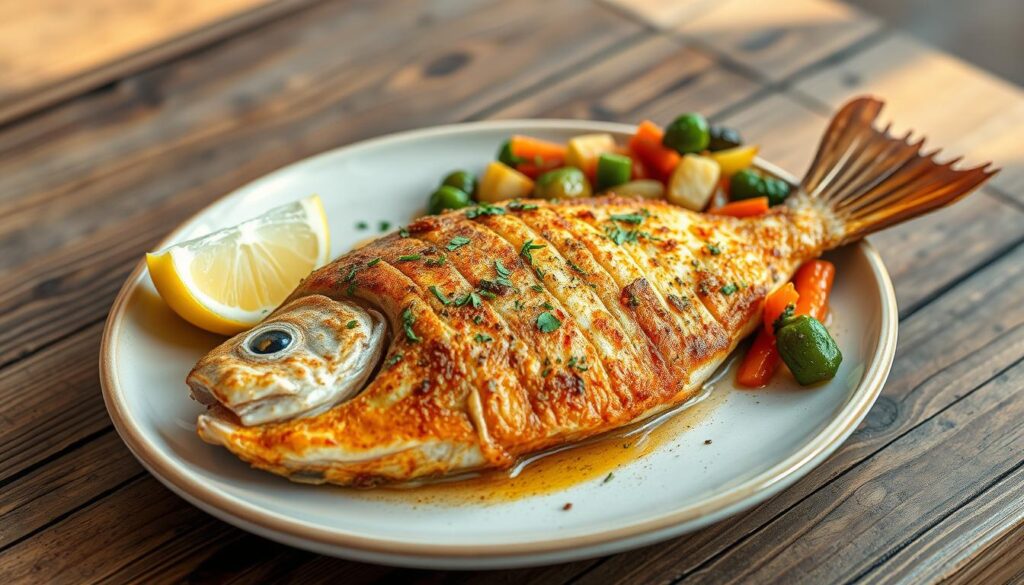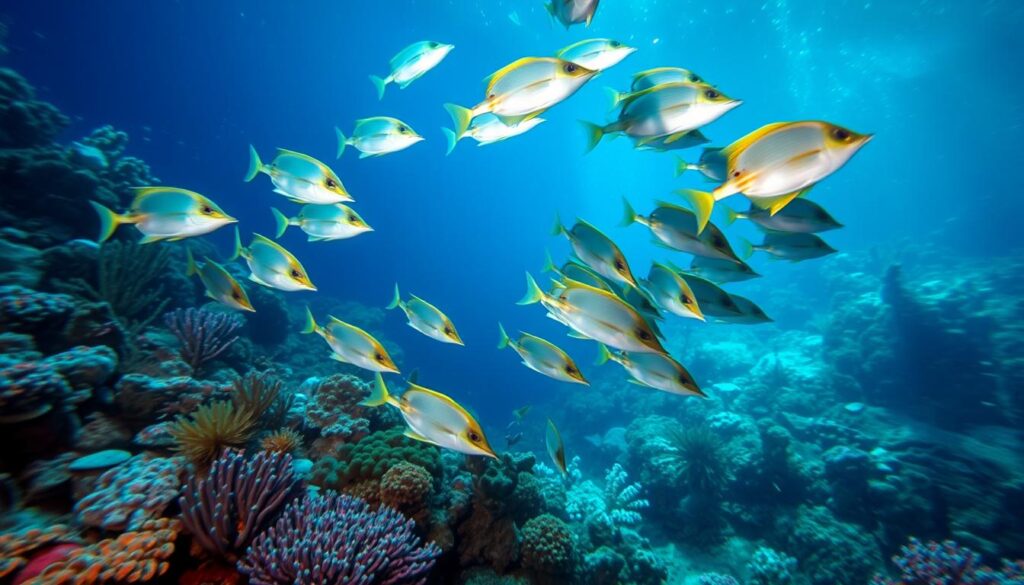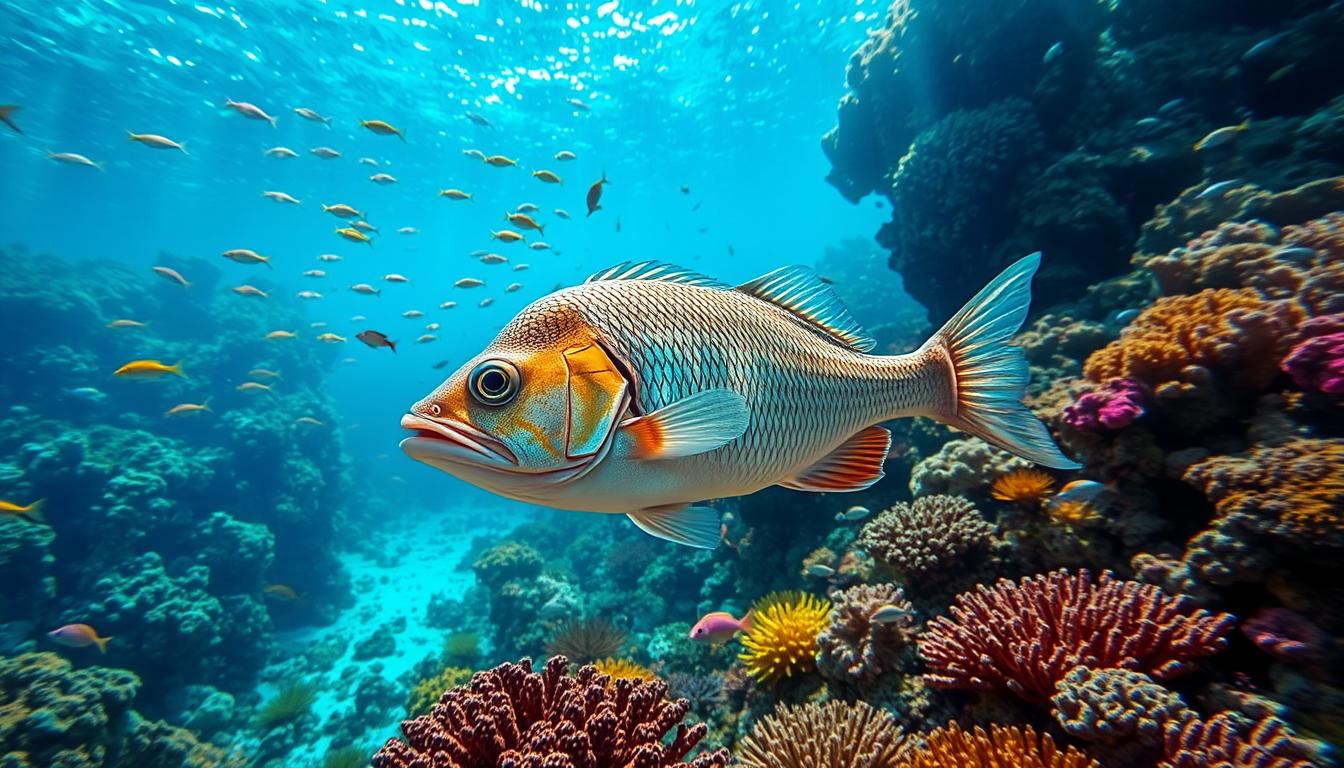Have you ever heard the distinctive croaking sound along the coastlines in warm summer months? This sound is often made by the Atlantic croaker. It’s a fish from the drum family that many anglers love to catch. But how much do you know about this fish and its role in the ocean? Let’s explore the secrets of the crocker fish together.
The Atlantic croaker, also known as the croaker fish, has a silver-grey color with pinkish or golden highlights. It can grow up to 18 to 27 inches long. This fish is special because it can make a croaking sound using muscles that vibrate its air bladder. This sound is how it got its name and is a sign of its presence in the sea.
The croaker fish is a favorite among recreational anglers from Massachusetts to the Gulf of Mexico. Its mild, white meat and large size make it a great catch. It’s not just fun to catch, but it also tastes great. So, what makes the croaker fish so special to the fishing community? Let’s find out in the next sections.
Table of Contents
Understanding the Crocker Fish Family
The croaker fish, also known as the hardhead croaker, is part of the drum family, or Sciaenidae. This family has about 293 to 298 species in 66 or 67 genera. The Atlantic Croaker (Micropogonias undulatus) is a well-known member.
Classification and Species Types
Sciaenidae, the drum family, includes small to medium-sized fishes found worldwide. They live in both freshwater and saltwater, mainly in estuaries, bays, and muddy river banks. Between 2000–2009, global landings were 431,000–780,000 tonnes, mostly from the western Indian Ocean and northwest Pacific.
Physical Characteristics and Features
Croaker fish, like the Atlantic Croaker, have a silver-grey body with pinkish or golden hues. They have a deep notch in their dorsal fin. An Atlantic Croaker is usually 18 to 27 inches long.
The Famous Croaking Sound Explained
Croaker fish are known for their unique croaking sound. This sound comes from muscles vibrating against their swim bladder. The croaking mechanism attracts mates, warns during feeding, and helps find each other in cloudy water. Different species have different croaking sounds.
Natural Habitat and Distribution Patterns
The Atlantic croakers live in many places, from Massachusetts to the Gulf of Mexico. They are found in Florida and Texas too. They love the muddy or sandy bottoms because they have lots of food there.
Water temperature is key for Atlantic croakers. They are most active when it’s over 75 degrees Fahrenheit. This usually happens in summer and fall. When it gets cooler, they move to offshore waters to spawn.
Atlantic croakers can live in many places, from estuaries to nearshore waters of the Gulf of Mexico. They are very adaptable. Their life in muddy bottoms shows how important they are for coastal ecosystems.
Biology and Behavior of Crocker Fish
Crocker fish, also known as bottom feeders, are found in coastal waters and estuaries worldwide. They are important in the marine ecosystem. They have unique ways of eating, reproducing, and growing.
Feeding Habits and Diet
Crocker fish mainly eat small invertebrates from the muddy or sandy bottoms. Their diet includes shrimp, crustaceans, and small fish. They use their croaking sound to find and catch prey.
Spawning and Reproduction
Crocker fish spawn in offshore waters in late summer and fall. Their croaking sounds are louder during this time. The eggs and larvae drift with the currents before settling in coastal areas.
Growth and Development Stages
The growth of crocker fish depends on water temperature and food. They go through stages from larvae to adults. As they grow, their croaking sound gets louder and more intense.
| Life Stage | Characteristics | Habitat |
|---|---|---|
| Larvae | Small, transparent bodies, limited swimming abilities | Drift with currents in offshore waters |
| Juveniles | Developing body features, increased swimming skills | Coastal estuaries and sheltered areas |
| Adults | Fully-formed bodies, distinct croaking sound | Coastal waters and offshore spawning grounds |
Knowing about crocker fish helps us understand these unique schooling fish. It shows their importance in the marine ecosystem.
Essential Fishing Gear and Equipment
For croaker fishing, the right gear is key to success. A 7-foot baitcasting or spinning rod with medium to heavy action is perfect. Match it with a reel in the 150/200 series for the right balance.
A two-hook or multi-hook bottom rig is a top choice for terminal tackle. Use 6 or 8 hooks for best results. Circle hooks are also great, especially for bigger croakers.
| Gear Recommendation | Details |
|---|---|
| Rod | 7-foot baitcasting or spinning rod with medium to heavy action |
| Reel | 150/200 series spinning reel |
| Line | 12-15 lb test monofilament |
| Hooks | Size 6 or 8 circle hooks |
| Rig | Two-hook or multi-hook bottom rig |
| Lures | 1/4 to 3/4 ounce lures for effective casting and fish landing |
With the right baitcasting rod, spinning reel, bottom rig, and circle hooks, you’re set to catch croakers. Don’t forget to check with your local tackle shop for more tips on gear and techniques.
Best Fishing Techniques and Strategies
To catch croaker fish, you need to know the best fishing methods. Let’s explore the top ways to make your croaker fishing trip a success.
Bottom Fishing Methods
Bottom fishing is the top choice for catching croakers. Use a simple bottom rig with a weight to keep it on the seabed. This lets you place your bait where croakers are most active.
Bait Selection and Preparation
Live and cut baits work well for croakers. Try using bloodworms, shrimp, squid, crabs, sand fleas, and nightcrawlers. Make sure your bait is fresh and ready to attract croakers.
Timing and Location Tips
Croakers are most active at night, making it the best time to fish for them. Look for spots near bridges, pier pilings, and in bays and surf zones. Cast your bait close to these spots and wait for the short, sharp tugs that mean a bite.
| Fishing Technique | Key Considerations |
|---|---|
| Bottom Fishing | Use a simple bottom rig with a weight that maintains contact with the seabed |
| Bait Selection | Live and cut baits like bloodworms, shrimp, squid, crabs, sand fleas, and nightcrawlers |
| Timing and Location | Target areas near structures like bridges and pier pilings, especially at night |
Using these top fishing techniques and strategies will help you catch croaker fish successfully.
Preparing and Cooking Your Catch
After catching your croaker fish, it’s time to make a tasty meal. The secret to enjoying this fish is in how you prepare and cook it. Let’s explore the steps to bring out the best in your croaker.
Filleting and Seasoning
Start by filleting the fish with a sharp knife. Carefully remove the fillets, making sure to avoid bones. Rinse them under cold water and dry with paper towels. Season with salt, pepper, and herbs to boost the fish’s flavor.
Cooking Methods
- Pan-frying is a favorite way to cook croaker. Coat the seasoned fillets in flour or cornmeal. Then, fry them in hot oil for 3-4 minutes on each side until golden.
- Baking is also great. Place the fillets on a rack in a baking dish. Bake at 375°F (190°C) for 15-20 minutes until flaky and cooked.
- For a quick option, try broiling. Place the fillets on a broiler-safe pan. Cook under high heat for 5-7 minutes, flipping halfway, for a grilled taste.
Choose your cooking method wisely. The key is to not overcook the delicate croaker fillets. Watch them closely and remove from heat when done.

With proper filleting, seasoning, and cooking techniques, you can fully enjoy your fresh croaker. It’s a seafood experience you won’t forget.
Nutritional Benefits and Health Value
Croaker fish is a great choice for a healthy diet. It’s packed with omega-3 fatty acids, protein, vitamin B12, selenium, and phosphorus. It’s perfect for pregnant women, kids, and anyone wanting to feel better.
Protein and Omega-3 Content
Croaker fish is full of high-quality protein. It has all the amino acids your body needs for muscles. It’s also low in mercury, safe for pregnant women and kids. Plus, it’s rich in omega-3 fatty acids for a healthy heart and brain.
Vitamins and Minerals
Croaker fish is a powerhouse of vitamin B12. It’s key for healthy blood cells and brain function. It also has lots of selenium for a strong immune system. And, it’s full of phosphorus for strong bones and teeth.
Health Advantages
Eating croaker fish can make you healthier. The omega-3 fatty acids are good for your heart. They lower heart disease risk and keep blood pressure in check. The selenium might help fight cancer, and vitamin B12 boosts brain power and energy. Plus, phosphorus is great for bones.
Adding croaker fish to your meals is a smart move. It’s tasty and full of nutrients. It’s good for you and your family’s health.
Seasonal Patterns and Migration
As the seasons change, the waters off the Pacific coast see a fascinating cycle with Crocker fish. These fish have unique seasonal patterns and migration habits. This gives anglers great opportunities for summer fishing and fall migration.
In the warmer months, especially July and September, Crocker fish are most active. They love the temperate coastal waters and estuaries, where they feed and grow. As summer warms the surface, they move closer to shore. This attracts recreational fishermen looking for a challenge and fun.
When autumn comes, Crocker fish start a remarkable migration. They head to the deeper, warmer offshore waters to spawn. This fall migration is a great chance for anglers to catch them in the open ocean, offering a new fishing experience.
Water temperature is key to Crocker fish’s seasonal movements. In warmer months, they stay in coastal areas. But as it cools, they move to deeper, warmer waters for their young. Knowing these patterns helps anglers find the best times and places to catch Crocker fish, whether in summer or fall.

| Season | Habitat | Fishing Opportunity |
|---|---|---|
| Summer | Coastal waters and estuaries | Excellent summer fishing for Crocker fish |
| Fall | Offshore, deeper waters | Exciting fall migration fishing |
Understanding Crocker fish’s seasonal patterns and migration helps anglers plan better. It increases their chances of success and lets them enjoy the unique experiences these fish offer all year.
Conclusion
Croaker fishing is a rewarding hobby for both new and experienced anglers. The species is found in many places, making it a favorite for those fishing along the Atlantic and Gulf coasts. Knowing where they live, how they behave, and the best fishing methods can really help you catch more.
It’s important to follow local fishing rules and use sustainable fishing methods. This helps keep croaker populations healthy for the future. By fishing responsibly, you can enjoy croaker fishing while helping to protect this marine resource.
Croakers are great for both sport and food, making them a popular choice for anglers. They are easy to find and catch, thanks to their wide distribution. With the right skills and knowledge, you can have a fun and successful time fishing for croakers.


1 thought on “Discover Crocker Fish: A Guide to This Unique Species”